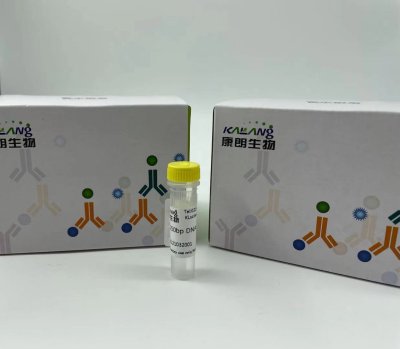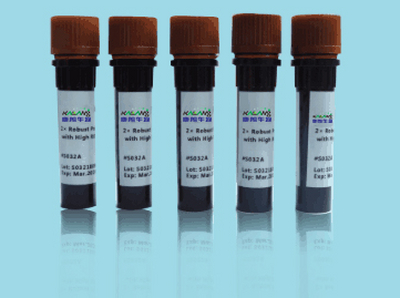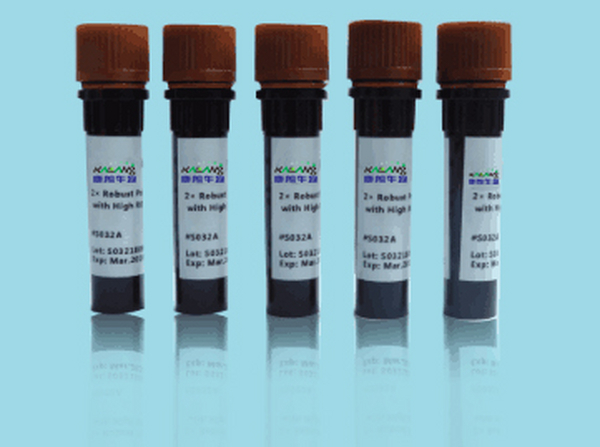QQ:3002763590


客服电话:021-61998208
Eotaxin rabbit Polyclonal Antibody
Eotaxin抗体
Eotaxin抗体应用:Western Blot: 1/500 - 1/2000. ELISA: 1/20000. C-C motif chemokine ligand 11(CCL11) Homo sapiens This antimicrobial gene is one of several chemokine genes clustered on the q-arm of chromosome 17. Chemokines form a superfamily of secreted proteins involved in immunoregulatory and inflammatory processes. The superfamily is divided into four subfamilies based on the arrangement of the N-terminal cysteine residues of the mature peptide. This chemokine, a member of the CC subfamily, displays chemotactic activity for eosinophils, but not mononuclear cells or neutrophils. This eosinophil-specific chemokine is thought to be involved in eosinophilic inflammatory diseases such as atopic dermatitis, allergic rhinitis, asthma and parasitic infections. [provided by RefSeq, Sep 2014],
Eotaxin-2 rabbit Polyclonal Antibody
Eotaxin-2抗体
Eotaxin-2抗体应用:IHC-p 1:50-200, ELISA 1:10000-20000 C-C motif chemokine ligand 24(CCL24) Homo sapiens This gene belongs to the subfamily of small cytokine CC genes. Cytokines are a family of secreted proteins involved in immunoregulatory and inflammatory processes. The CC cytokines are proteins characterized by two adjacent cysteines. The cytokine encoded by this gene displays chemotactic activity on resting T lymphocytes, a minimal activity on neutrophils, and is negative on monocytes and activated T lymphocytes. The protein is also a strong suppressor of colony formation by a multipotential hematopoietic progenitor cell line. [provided by RefSeq, Jul 2008],
Eotaxin-3 rabbit Polyclonal Antibody
Eotaxin-3抗体
Eotaxin-3抗体应用:Western Blot: 1/500 - 1/2000. IHC-p: 1:100-300 ELISA: 1/20000. C-C motif chemokine ligand 26(CCL26) Homo sapiens This gene is one of two Cys-Cys (CC) cytokine genes clustered on the q arm of chromosome 7. Cytokines are a family of secreted proteins involved in immunoregulatory and inflammatory processes. The CC cytokines are proteins characterized by two adjacent cysteines. The cytokine encoded by this gene displays chemotactic activity for normal peripheral blood eosinophils and basophils. The product of this gene is one of three related chemokines that specifically activate chemokine receptor CCR3. This chemokine may contribute to the eosinophil accumulation in atopic diseases. [provided by RefSeq, Jul 2008],
EP1 rabbit Polyclonal Antibody
EP1抗体
EP1抗体应用:Western Blot: 1/500 - 1/2000. ELISA: 1/20000. prostaglandin E receptor 1(PTGER1) Homo sapiens The protein encoded by this gene is a member of the G protein-coupled receptor family. This protein is one of four receptors identified for prostaglandin E2 (PGE2). Through a phosphatidylinositol-calcium second messenger system, G-Q proteins mediate this receptor's activity. Knockout studies in mice suggested a role of this receptor in mediating algesia and in regulation of blood pressure. Studies in mice also suggested that this gene may mediate adrenocorticotropic hormone response to bacterial endotoxin. [provided by RefSeq, Jul 2008],
EP2 rabbit Polyclonal Antibody
EP2抗体
EP2抗体应用:Western Blot: 1/500 - 1/2000. Immunofluorescence: 1/200 - 1/1000. ELISA: 1/10000. prostaglandin E receptor 2(PTGER2) Homo sapiens This gene encodes a receptor for prostaglandin E2, a metabolite of arachidonic acid which has different biologic activities in a wide range of tissues. Mutations in this gene are associated with aspirin-induced susceptibility to asthma. [provided by RefSeq, Oct 2009],
EP2 rabbit Polyclonal Antibody
EP2抗体
EP2抗体应用:Western Blot: 1/500 - 1/2000. Immunofluorescence: 1/200 - 1/1000. ELISA: 1/10000. prostaglandin E receptor 2(PTGER2) Homo sapiens This gene encodes a receptor for prostaglandin E2, a metabolite of arachidonic acid which has different biologic activities in a wide range of tissues. Mutations in this gene are associated with aspirin-induced susceptibility to asthma. [provided by RefSeq, Oct 2009],
EP3 rabbit Polyclonal Antibody
EP3抗体
EP3抗体应用:Western Blot: 1/500 - 1/2000. Immunofluorescence: 1/200 - 1/1000. ELISA: 1/10000. prostaglandin E receptor 3(PTGER3) Homo sapiens The protein encoded by this gene is a member of the G-protein coupled receptor family. This protein is one of four receptors identified for prostaglandin E2 (PGE2). This receptor may have many biological functions, which involve digestion, nervous system, kidney reabsorption, and uterine contraction activities. Studies of the mouse counterpart suggest that this receptor may also mediate adrenocorticotropic hormone response as well as fever generation in response to exogenous and endogenous stimuli. Multiple transcript variants encoding different isoforms have been found for this gene. [provided by RefSeq, Aug 2009],
EP3 rabbit Polyclonal Antibody
EP3抗体
EP3抗体应用:Western Blot: 1/500 - 1/2000. Immunohistochemistry: 1/100 - 1/300. Immunofluorescence: 1/200 - 1/1000. ELISA: 1/20000. prostaglandin E receptor 3(PTGER3) Homo sapiens The protein encoded by this gene is a member of the G-protein coupled receptor family. This protein is one of four receptors identified for prostaglandin E2 (PGE2). This receptor may have many biological functions, which involve digestion, nervous system, kidney reabsorption, and uterine contraction activities. Studies of the mouse counterpart suggest that this receptor may also mediate adrenocorticotropic hormone response as well as fever generation in response to exogenous and endogenous stimuli. Multiple transcript variants encoding different isoforms have been found for this gene. [provided by RefSeq, Aug 2009],
EP3A rabbit Polyclonal Antibody
EP3A抗体
EP3A抗体应用:WB 1:500-2000 Testicular sperm are morphologically differentiated but are not progressively motile nor able to fertilize an egg. Post-testicular maturation requires exposure of spermatozoa to the microenvironment of the epididymal lumen. Spermatozoa undergo extensive changes in the epididymis, including enzymatic modifications, loss of pre-existing components and addition of new glycoproteins from epididymal secretions. These modifying proteins and enzymes are synthesized by epithelial cells lining the epididymal duct and secreted apically into the lumen, where they come into contact with, and may be absorbed onto, the sperm membranes. The proteins encoded by the genes in this cluster are synthesized and secreted by epididymal epithelial cells. [provided by RefSeq, Jul 2008],
EP4 rabbit Polyclonal Antibody
EP4抗体
EP4抗体应用:Western Blot: 1/500 - 1/2000. Immunofluorescence: 1/200 - 1/1000. ELISA: 1/20000. prostaglandin E receptor 4(PTGER4) Homo sapiens The protein encoded by this gene is a member of the G-protein coupled receptor family. This protein is one of four receptors identified for prostaglandin E2 (PGE2). This receptor can activate T-cell factor signaling. It has been shown to mediate PGE2 induced expression of early growth response 1 (EGR1), regulate the level and stability of cyclooxygenase-2 mRNA, and lead to the phosphorylation of glycogen synthase kinase-3. Knockout studies in mice suggest that this receptor may be involved in the neonatal adaptation of circulatory system, osteoporosis, as well as initiation of skin immune responses. [provided by RefSeq, Jul 2008],
最新动态
-

Anti-GNGT1 KL20092-001(50ul)
2021-10-11 -

Anti-GNGT1 antibody(50ul) KL20093-001
2021-10-11 -

MUC5AC (PT2058) mouse Monoclonal Antibody
2021-01-06 -

mOrange mouse Monoclonal Antibody(Mix)
2021-01-05
热门标签
- Histone H3 rabbit Polyclonal Antibody Histone H3抗体
- EGFR rabbit Polyclonal Antibody EGFR抗体
- Cy3 Conjugated
- AbFluor™ 555 Conjugated
- AbFluor™ 680 Conjugated
- AbFluor™ 350 Conjugated
- AbFluor™ 647 Conjugated
- AbFluor™ 594 Conjugated
- AbFluor™ 405 Conjugated
- Cy5 Conjugated
- AbFluor™ 488 Conjugated
- Cyclophilin B抗体 Cyclophilin B Monoclonal Antibody(2B10)
- COX IV抗体 COX IV Monoclonal Antibody(6C8)
- PCNA抗体 PCNA Monoclonal Antibody(12D10)
- FAK rabbit Polyclonal Antibody FAK抗体
邮箱:3002763590@qq.com
电话:021-61998208

扫码关注微信公众号






